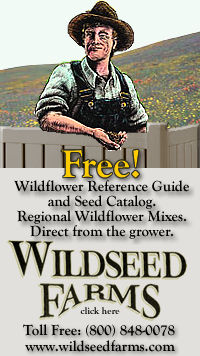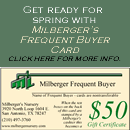 WILDSCAPING TO ATTRACT HUMMINGBIRDS
WILDSCAPING TO ATTRACT HUMMINGBIRDS
Wildscape is just a version
of xeriscape that uses drought resistant plants that meet the
needs of wildlife. Hummingbirds are one of the primary targets
of wildscaping.
The hummingbirds should return to San Antonio soon. If
you have Texas Gold columbines or crossvine watch for them on
the blooms; traditionally, that is where I notice them first.
The lavender lantana and Salvia greggii are also blooming well
because of the mild winter. Hummingbirds like those blooms as
well.
Later in the summer the blue salvias
(indigo spires, Mexican bush sage, mealy blue sage) are good
hummingbirds plants. In the shade, shrimp plant, Turk’s
cap and pentas attract the birds. Pentas also make a good hummingbird
attracting container plant for the patio. The pentas are very
effective in morning sun. If you have full sun on the patio,
firebush is a must. In a container it does not have the drought
defying abilities that it does when it is planted in the ground,
but it is the best hummingbird-attracting plant in my yard.
Other outstanding full sun plants that
are good hummingbird food sources are Texas bells (esperanza)
and poinciana (Pride of Barbados). Both plants prosper in droughty
conditions and are root hardy plants that can reach 8 to 10
feet in sheltered locations or if the winters are mild. Texas
bells has a yellow bloom and poinciana is glow-in-the-dark orange.
The Mexican selection of poinciana has a yellower flower, not
quite as showy as the orange version but equally attractive
to hummingbirds.
For deep shade, the late season hummingbird
plant is firespike. Firespike has large, shiny, green leaves
that are so attractive that some gardeners bring potted firespike
into the house in the winter to protect it from the cold and
to serve as an indoor foliage plant. Planted in the ground in
deep shade it freezes back to the ground every winter after
producing spikes above the foliage with striking red blooms.
Firespike and the pentas described
earlier are not usually thought of as xeriscape plants but fit
in a xeriscape if they are planted in soil enriched with compost
and are mulched.
Irises are blooming now and the daylilies
will be blooming in early summer. They sometimes attract hummingbirds.
A plant with similar upright foliage that makes a good lush
liriope-like groundcover and is attractive to hummingbirds is
red hot poker (Tritoma). The blooms look like glowing torches
for a short bloom period every spring. In my yard, of the plants
mentioned, the deer do not eat Turk’s cap, shrimp plant,
red hot poker, lantana, iris, Salvia, and esperanza.
In addition to planting a mix of flowering
plants from early spring until deep winter, those of us who
want to attract hummingbirds to our gardens feed sugar water
to the interesting little birds.
Obtain a sugar water feeder from your
favorite nursery or wild bird supply store. Or, better yet,
obtain more than one. Hummingbirds will squabble and chase each
other but a large number, especially in spring or fall during
migration, will share a yard. H.E.B. stores even sell the Best
A-1 hummingbird feeders manufactured in Poteet, Texas.
I like to place my feeders under the
eaves or under an open part of the trellis in a spot that is
easy to observe from the window or patio table.
You can purchase the colored sugar
from the feeder supplier but sugar from the pantry works just
as well. Mix four parts water with one part sugar by volume
and stir until the sugar dissolves. My wife places her sugar
and water in the microwave for 10 minutes to dissolve the solution.
Store extra mix in gallon plastic milk jugs in the refrigerator.
There are some minor disputes in the
bird-watching world about coloring the sugar water and how often
the feeder should be cleaned. We use red food coloring although
it is not necessary to attract the birds. There is no evidence
that it hurts hummingbirds. It is probably a good plan to rinse
your feeders out every week and add fresh sugar water. Definitely
change out the solution if it clouds or bees get in the solution.
Almost all brands of feeders have bee
guards to keep the hungry, thirsty bees from dominating the
feeders during periods when flower blooms are hard to find (winter,
droughts). Unfortunately, golden-fronted woodpeckers have developed
a taste for sugar water and are able to remove the bee guards.
The bees enter the feeders and, in their zeal, often drown.






